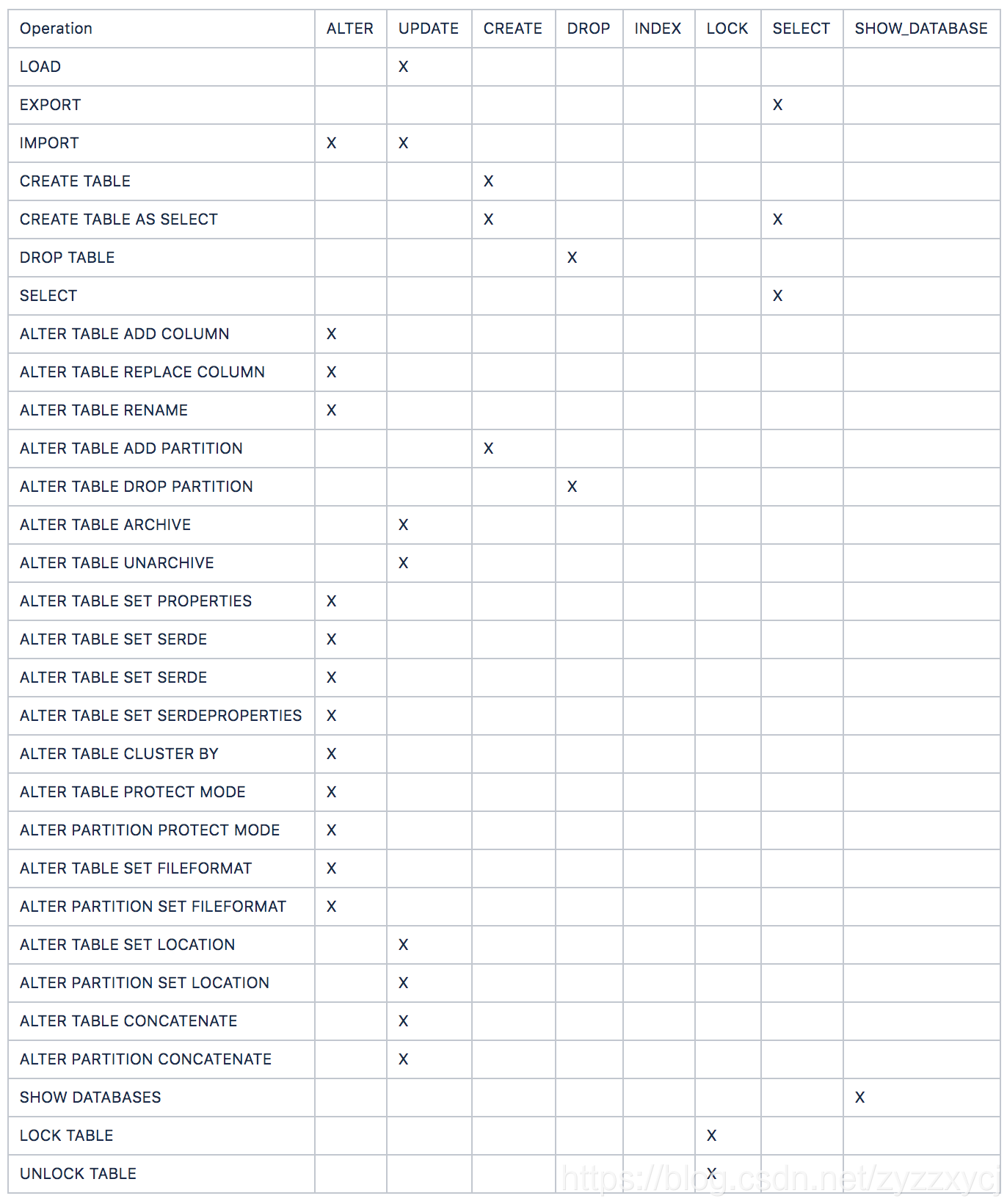1、前言
前段时间,在升级Hive版本(从Hive1.1.0升级至Hive2.3.6)的过程中,遇到了权限兼容问题。
(升级相关请移步Hive1.1.0升级至2.3.6 踩坑记录)
Hive1.1.0使用的是AuthorizerV1而Hive2.3.6默认是AuthorizerV2,两者相差极大。
其中AuthorizerV2的权限验证极为严格,如果曾经使用V1鉴权想要使用V2的,需要修改部分代码,这是我提交的patch,供参考HIVE-22830
2、权限认证
v1和v2的权限授权和查询,在SQL语法上是通用的,因此我们不需要对Hive授权相关的系统做代码上的修改。
v1权限认证
(org.apache.hadoop.hive.ql.security.authorization.DefaultHiveAuthorizationProvider):官方文档
总共有ALL | ALTER | UPDATE | CREATE | DROP | INDEX | LOCK | SELECT | SHOW_DATABASE这几种权限类型。
相关Hive操作所需要的权限如下表:

v2权限认证
(org.apache.hadoop.hive.ql.security.authorization.plugin.sqlstd.SQLStdHiveAuthorizerFactory):官方文档
总共有INSERT | SELECT | UPDATE | DELETE | ALL这几种类型的权限。
相关Hive操作所需要的权限如下表:
Y代表需要有该权限
Y+G代表不仅需要有改权限,还必须是能给别人赋权的权限(“WITH GRANT OPTION”)

来说说两者在一些细节上的区别:
1、v2的ALL权限在mysql中会分成INSERT | SELECT | UPDATE | DELETE 来保存,而v1则是直接存ALL。
2、v1对库授权,则用户/角色对该库下的所有表都有相应的权限,而v2必须对表一一授权。
3、v1如果需要删库/表,只需要拥有对应的drop权限即可,而v2如果需要删库/表,必须是该库/表的owner,这个owner可以是用户或者角色。
3、源码解析(Hive3.1版本)
在Hive SQL执行全过程源码解析中,介绍了Driver.compile中权限认证的入口:


接下来着重看下v2权限认证的实现:

如何判断是用v1或v2进行认证?
if (ss.isAuthorizationModeV2())
-> public boolean isAuthorizationModeV2(){
return getAuthorizationMode() == AuthorizationMode.V2;
}
--> public AuthorizationMode getAuthorizationMode(){
setupAuth();
// 判断在初始化操作setupAuth()后,authorizer是否为null
// 优先判断是否为v1
if(authorizer != null){
return AuthorizationMode.V1;
}else if(authorizerV2 != null){
return AuthorizationMode.V2;
}
}
setupAuth():
/**
* Setup authentication and authorization plugins for this session.
*/
private void setupAuth() {
// 已经被初始化了,直接返回
if (authenticator != null) {
// auth has been initialized
return;
}
try {
// 通过获取hive.security.authenticator.manager参数来决定authenticator
authenticator = HiveUtils.getAuthenticator(sessionConf,
HiveConf.ConfVars.HIVE_AUTHENTICATOR_MANAGER);
authenticator.setSessionState(this);
// 获取hive.security.authorization.manager参数,为权限验证实现类名
// 决定了使用v1还是v2
// Hive1默认v1:(org.apache.hadoop.hive.ql.security.authorization.DefaultHiveAuthorizationProvider)
// Hive2及以后默认v2:(org.apache.hadoop.hive.ql.security.authorization.plugin.sqlstd.SQLStdHiveAuthorizerFactory)
String clsStr = HiveConf.getVar(sessionConf, HiveConf.ConfVars.HIVE_AUTHORIZATION_MANAGER);
// 使用反射尝试实例化权限认证类对象
// 生成HiveAuthorizationProvider对象,v1
authorizer = HiveUtils.getAuthorizeProviderManager(sessionConf,
clsStr, authenticator, true);
if (authorizer == null) {
// if it was null, the new (V2) authorization plugin must be specified in
// config
// 实现和v1大致相同,使用反射尝试实例化权限认证类对象
HiveAuthorizerFactory authorizerFactory = HiveUtils.getAuthorizerFactory(sessionConf,
HiveConf.ConfVars.HIVE_AUTHORIZATION_MANAGER);
HiveAuthzSessionContext.Builder authzContextBuilder = new HiveAuthzSessionContext.Builder();
authzContextBuilder.setClientType(isHiveServerQuery() ? CLIENT_TYPE.HIVESERVER2
: CLIENT_TYPE.HIVECLI);
authzContextBuilder.setSessionString(getSessionId());
// 生成HiveAuthorizer对象,v2
authorizerV2 = authorizerFactory.createHiveAuthorizer(new HiveMetastoreClientFactoryImpl(),
sessionConf, authenticator, authzContextBuilder.build());
setAuthorizerV2Config();
}
// create the create table grants with new config
createTableGrants = CreateTableAutomaticGrant.create(sessionConf);
} catch (HiveException e) {
LOG.error("Error setting up authorization: " + e.getMessage(), e);
throw new RuntimeException(e);
}
if(LOG.isDebugEnabled()){
Object authorizationClass = getActiveAuthorizer();
LOG.debug("Session is using authorization class " + authorizationClass.getClass());
}
return;
}
继续看v2的实现:
ss.getAuthorizerV2().checkPrivileges(hiveOpType, inputsHObjs, outputHObjs, authzContextBuilder.build());
-> public void checkPrivileges(HiveOperationType hiveOpType, List<HivePrivilegeObject> inputHObjs,
List<HivePrivilegeObject> outputHObjs, HiveAuthzContext context)
throws HiveAuthzPluginException, HiveAccessControlException {
authValidator.checkPrivileges(hiveOpType, inputHObjs, outputHObjs, context);
}
--> public void checkPrivileges(HiveOperationType hiveOpType, List<HivePrivilegeObject> inputHObjs,
List<HivePrivilegeObject> outputHObjs, HiveAuthzContext context)
throws HiveAuthzPluginException, HiveAccessControlException {
if (LOG.isDebugEnabled()) {
String msg = "Checking privileges for operation " + hiveOpType + " by user "
+ authenticator.getUserName() + " on " + " input objects " + inputHObjs
+ " and output objects " + outputHObjs + ". Context Info: " + context;
LOG.debug(msg);
}
String userName = authenticator.getUserName();
// 获取metastore api入口
IMetaStoreClient metastoreClient = metastoreClientFactory.getHiveMetastoreClient();
// check privileges on input and output objects
List<String> deniedMessages = new ArrayList<String>();
// 分别对输入输出鉴权,结果计入deniedMessages
checkPrivileges(hiveOpType, inputHObjs, metastoreClient, userName, IOType.INPUT, deniedMessages);
checkPrivileges(hiveOpType, outputHObjs, metastoreClient, userName, IOType.OUTPUT, deniedMessages);
// 若deniedMessages大小不为0,则权限不足,抛出异常
SQLAuthorizationUtils.assertNoDeniedPermissions(new HivePrincipal(userName,
HivePrincipalType.USER), hiveOpType, deniedMessages);
}
checkPrivileges:

getPrivilegesFromMetaStore:
...
thrifPrivs = metastoreClient.get_privilege_set(objectRef, userName, null);
-> public PrincipalPrivilegeSet get_privilege_set(HiveObjectRef hiveObject,
String userName, List<String> groupNames) throws MetaException,
TException {
if (!hiveObject.isSetCatName()) {
hiveObject.setCatName(getDefaultCatalog(conf));
}
// 访问metastore
return client.get_privilege_set(hiveObject, userName, groupNames);
}
...
get_privilege_set:

这边以获取表权限为例,get_table_privilege_set:

getTablePrivilege:

listAllMTableGrants:

package.jdo:

至此,权限认证核心部分的代码已经梳理完了,如果对JDO不是很熟悉,可以看一下JDOQL官方文档。
再回到Driver.doAuthorization,如果不走v2则会默认进行v1鉴权,其底层实现也是同v2一样,通过连metastore查库获取权限信息,然后比对。
// 进行v1权限认证
HiveAuthorizationProvider authorizer = ss.getAuthorizer();
if (op.equals(HiveOperation.CREATEDATABASE)) {
// 建库鉴权
authorizer.authorize(
op.getInputRequiredPrivileges(), op.getOutputRequiredPrivileges());
} else if (op.equals(HiveOperation.CREATETABLE_AS_SELECT)
|| op.equals(HiveOperation.CREATETABLE)) {
// 建表鉴权
authorizer.authorize(
db.getDatabase(SessionState.get().getCurrentDatabase()), null,
HiveOperation.CREATETABLE_AS_SELECT.getOutputRequiredPrivileges());
} else {
if (op.equals(HiveOperation.IMPORT)) {
ImportSemanticAnalyzer isa = (ImportSemanticAnalyzer) sem;
if (!isa.existsTable()) {
// 导入(import)鉴权
authorizer.authorize(
db.getDatabase(SessionState.get().getCurrentDatabase()), null,
HiveOperation.CREATETABLE_AS_SELECT.getOutputRequiredPrivileges());
}
}
}
if (outputs != null && outputs.size() > 0) {
for (WriteEntity write : outputs) {
if (write.isDummy() || write.isPathType()) {
continue;
}
if (write.getType() == Entity.Type.DATABASE) {
if (!op.equals(HiveOperation.IMPORT)){
// We skip DB check for import here because we already handle it above
// as a CTAS check.
// 写库鉴权
authorizer.authorize(write.getDatabase(),
null, op.getOutputRequiredPrivileges());
}
continue;
}
if (write.getType() == WriteEntity.Type.PARTITION) {
Partition part = db.getPartition(write.getTable(), write
.getPartition().getSpec(), false);
if (part != null) {
// 写分区鉴权
authorizer.authorize(write.getPartition(), null,
op.getOutputRequiredPrivileges());
continue;
}
}
// 写表鉴权
if (write.getTable() != null) {
authorizer.authorize(write.getTable(), null,
op.getOutputRequiredPrivileges());
}
}
}
// 之后就是对读取的鉴权,不一一注释了。
// 其底层实现也是同v2一样,连metastore查库获取权限信息,然后比对。
if (inputs != null && inputs.size() > 0) {
Map<Table, List<String>> tab2Cols = new HashMap<Table, List<String>>();
Map<Partition, List<String>> part2Cols = new HashMap<Partition, List<String>>();
//determine if partition level privileges should be checked for input tables
Map<String, Boolean> tableUsePartLevelAuth = new HashMap<String, Boolean>();
for (ReadEntity read : inputs) {
if (read.isDummy() || read.isPathType() || read.getType() == Entity.Type.DATABASE) {
continue;
}
Table tbl = read.getTable();
if ((read.getPartition() != null) || (tbl != null && tbl.isPartitioned())) {
String tblName = tbl.getTableName();
if (tableUsePartLevelAuth.get(tblName) == null) {
boolean usePartLevelPriv = (tbl.getParameters().get(
"PARTITION_LEVEL_PRIVILEGE") != null && ("TRUE"
.equalsIgnoreCase(tbl.getParameters().get(
"PARTITION_LEVEL_PRIVILEGE"))));
if (usePartLevelPriv) {
tableUsePartLevelAuth.put(tblName, Boolean.TRUE);
} else {
tableUsePartLevelAuth.put(tblName, Boolean.FALSE);
}
}
}
}
// column authorization is checked through table scan operators.
getTablePartitionUsedColumns(op, sem, tab2Cols, part2Cols, tableUsePartLevelAuth);
// cache the results for table authorization
Set<String> tableAuthChecked = new HashSet<String>();
for (ReadEntity read : inputs) {
// if read is not direct, we do not need to check its autho.
if (read.isDummy() || read.isPathType() || !read.isDirect()) {
continue;
}
if (read.getType() == Entity.Type.DATABASE) {
authorizer.authorize(read.getDatabase(), op.getInputRequiredPrivileges(), null);
continue;
}
Table tbl = read.getTable();
if (tbl.isView() && sem instanceof SemanticAnalyzer) {
tab2Cols.put(tbl,
sem.getColumnAccessInfo().getTableToColumnAccessMap().get(tbl.getCompleteName()));
}
if (read.getPartition() != null) {
Partition partition = read.getPartition();
tbl = partition.getTable();
// use partition level authorization
if (Boolean.TRUE.equals(tableUsePartLevelAuth.get(tbl.getTableName()))) {
List<String> cols = part2Cols.get(partition);
if (cols != null && cols.size() > 0) {
authorizer.authorize(partition.getTable(),
partition, cols, op.getInputRequiredPrivileges(),
null);
} else {
authorizer.authorize(partition,
op.getInputRequiredPrivileges(), null);
}
continue;
}
}
// if we reach here, it means it needs to do a table authorization
// check, and the table authorization may already happened because of other
// partitions
if (tbl != null && !tableAuthChecked.contains(tbl.getTableName()) &&
!(Boolean.TRUE.equals(tableUsePartLevelAuth.get(tbl.getTableName())))) {
List<String> cols = tab2Cols.get(tbl);
if (cols != null && cols.size() > 0) {
authorizer.authorize(tbl, null, cols,
op.getInputRequiredPrivileges(), null);
} else {
authorizer.authorize(tbl, op.getInputRequiredPrivileges(),
null);
}
tableAuthChecked.add(tbl.getTableName());
}
}
}
























 981
981











 被折叠的 条评论
为什么被折叠?
被折叠的 条评论
为什么被折叠?








